Madison Bicycle Adventure Trail (MadBAT) Network
Cannonball Bicycle Adventure Trail at Aldo Leopold Park
Running parallel to the existing Cannonball Path, the Cannonball Bicycle Adventure Trail offers a unique and fun biking experience for all skill levels. The narrow trail or “singletrack” is about the width of a bike and provides adventures for riders with “shred to school,” hills, jumps, decking and berms through woodsy natural, limestone and chip seal trails. The adventure trail is approximately one mile and runs north from Post Road to just south of the beltline (Hwy 151) and has several access points including at Aldo Leopold Park. Trail conditions are periodically posted by users on Capital Off-Road Pathfinders.
Bike Skills Track at Sandburg Park
Pre-fabricated wood ramps and bridges make for a fun and unique biking adventure at Sandburg Park. The loop track is approximate 700’ and adjacent to Sandburg Elementary School.
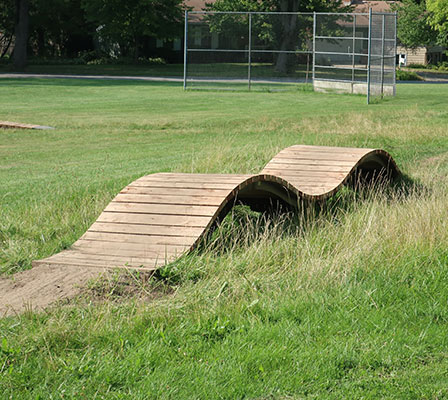
What is the Madison Bicycle Adventure Trail Network?
While Madison is known for its plentiful hard-surface biking infrastructure, natural surface connections and singletrack networks close to neighborhoods can be difficult to find. Natural surface trails, singletrack trails, and bike optimized park facilities encourage access for a range of trail users and riders from the occasional enthusiast to the serious athlete. Natural surface trail networks are shown to improve community health, create equitable access, increase youth engagement, and drive positive economic impacts.
The City of Madison Parks Division has engaged the International Mountain Bicycling Association (IMBA) - Trail Solutions Program to complete a citywide feasibility study and planning exercise. Adding to the momentum, Madison Parks received a matching funds grant for $20,000 from IMBA to develop a trail concept plan connecting greenspaces throughout the city.
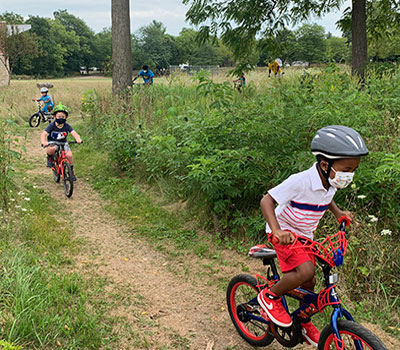
Photo Credit: Mike Repyak
The goals of the project are to develop a connected network of natural surfaces and identify locations for bike skills development features, bike parks, and bicycle playgrounds. The project will analyze existing public lands and current bike/pedestrian networks in Madison, propose improvements to those lands and infrastructure, and design connectivity to adjacent county and municipal properties. It will also evaluate how these physical components interact with diverse demographics throughout Madison and listen to the trail-based experiences and interests of riders and non-riders.
The project includes meeting with key City of Madison agencies, and external partners such as Dane County Parks and Capital Off Road Pathfinders, and gather public input through an online survey, listening sessions, and digital exhibits. The community will have opportunities to review and comment throughout the project.
Additional Info
Why Trails?
Bike trails encourage outdoor recreation, which creates a positive impact on a person’s physical health and mental wellness.
Recent studies show the positive impacts of trails close to home. In general, these studies show that close proximity of trails to one’s home and neighborhood provides easier access and greater use, which results in improved physical and mental health. Additionally, in a 2011 study, the American Heart Association found with each $1 of trail construction directly results in $3 of medical cost savings.
The process of trail planning, construction, and use is a catalyst for community immersion. Examples include neighbors engaging in public infrastructure improvements, trails connecting residents to nearby gathering spaces and businesses, and trail-based events attracting nearby and community residents. Trail beautification art projects and volunteer trail maintenance days also bring the community together in a positive manner.
Additional Info
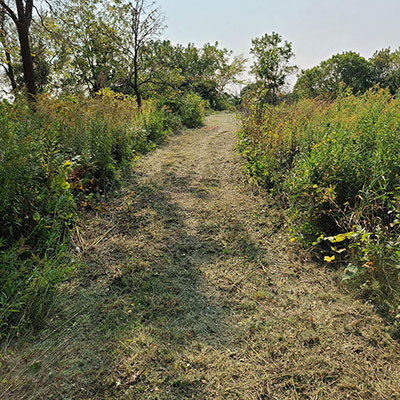
Trails in close proximity to neighborhoods, schools, public gathering spaces, and business districts are a driver for youth engagement, equitable access, and activities that encourage inclusion, and new trail users.
Equity is one of four Guiding Lenses in the City of Madison’s 2018-2023 Park and Open Space Plan. As stated in the plan, “A focus on equity is imperative to achieving the Parks Division’s vision of providing parks to all Madison residents. The Parks Division recognizes that thoroughly understanding the population it serves is the first step towards developing an inclusive parks system.” In addition to developing park and trail infrastructure close to neighborhoods, trail use education and programming eases the barrier for new bike and trail users. Informational resources and bike-based programming encourages trail use for all. Programming examples include:
- Free Bikes 4 Kids delivers bikes to families in need.
- Madison School & Community Recreation (MSCR) offers Learn 2 Ride training events.
- Bike Madison teaches children to ride safely through after school and summer classes.
- Black Girls Do Bike provides a biking community for women and girls of color.
- Bell Joy Ride organizes women only rides.
Additional Info
- Diversify Outdoors
- Benefits of Trails & Greenways, National Park Service
Trail connectivity and quality outdoor recreation contribute to economic growth.
A well-designed natural surface trail system can stimulate economic growth by increasing activity within the local population as well as attracting visitors from outside. Trails generate business in retail sales and services, support jobs, provide sustainable growth in communities, and produce tax revenue. Access to trails also correlates to a higher quality of life, thus making the community more desirable and capable of attracting new businesses and workers to an area.
Communities throughout North America see increasing bicycling tourism as a sustainable, renewable source of economic development. A bike experience-based destination is one that attracts tourists to an area for the benefits of the trails; provides visitors with all of the amenities needed to compliment, ease, and enhance their visit; and in-turn creates word-of-mouth promotion about the community that will draw new and repeat visits.
Additional Info
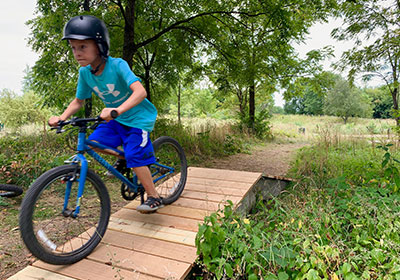
Sustainable Trails and Preserving Open Space
A sustainable trail balances many elements. It has little impact on the environment; resists erosion through proper design, construction, and maintenance; and blends with the surrounding area. A sustainable trail also appeals to and serves a variety of users over many years. It is designed to provide enjoyable and challenging experiences for visitors by managing their expectations effectively. Following sustainable trail design and construction guidelines allows for high-quality trail and education experiences for users while protecting the land’s sensitive resources. For additional trail design, construction, and maintenance techniques, refer to Trail Solutions: IMBA’s Guide to Building Sweet Singletrack. These guidelines are appropriate for any pedestrian- and bike-based trail development.
Trails make communities better places to live by preserving and creating open spaces for recreation. Greenways function as recreational corridors and hands-on environmental classrooms for people of all ages, providing opportunities to enjoy nature up close. Open spaces can decrease pollution, protect water quality, and reduce soil erosion.
Additional Info
Bike-Optimized Trails and Facilities
Bikers have become sophisticated, seeking purpose-built trails that offer a wide range of difficulty levels, terrain diversity, and genres. Bike-optimized trails, also called purpose-built trails, are designed and constructed to enhance trail experiences specifically for trail and bmx bikes. Bike-optimized trails might differ from traditional trails in several ways: enhanced tread shaping, one-way travel, and the addition of man-made technical trail features (TTFs). Bicycles move differently along a trail than other modes of transportation, offering both opportunities and constraints for trails and trail features that may differ from those of other users.
One-way, bike-optimized trails that harness gravity are a growing area of interest for trail riders. These trails can be designed and built at any level, from beginner friendly flow trails to difficult feature-rich trails. Riders cherish the feeling of flight that a bicycle provides while cruising through a succession of bike-optimized features from top to bottom. Well-designed, mountain bike-optimized trails are exciting for mountain bikers but are also designed to help manage risk and minimize user conflict.
Appropriate trail types, technical trail features, and bike-optimized facilities will be detailed in the MadBAT network feasibility report. These may include traditional singletrack, bike-optimized singletrack, bike gravity singletrack, bicycle playgrounds, pumptracks, pump parks, skills development features (bridges, skinny’s, drops, rock gardens), dirt jumps, and technical challenge loops.
Additional Info
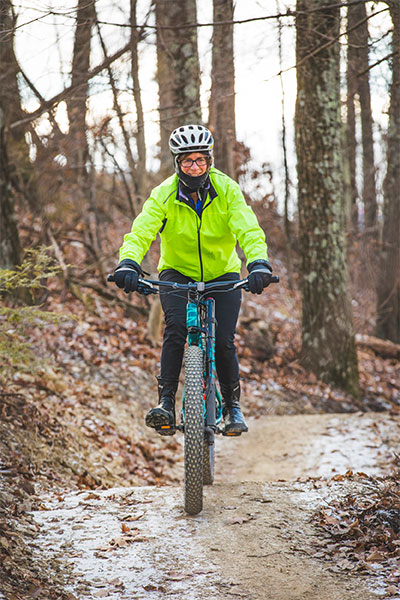
Photo Credit: Robert King

